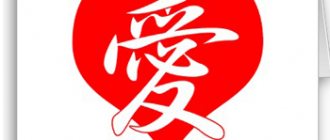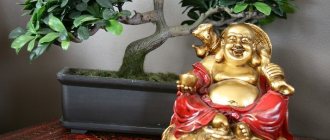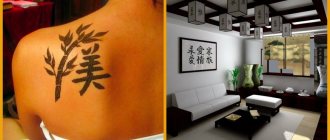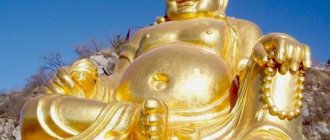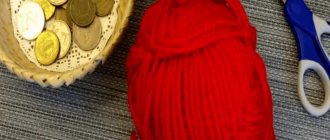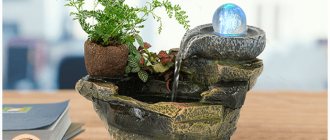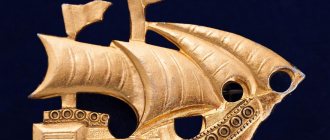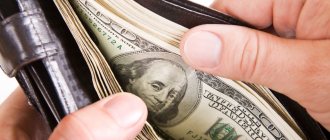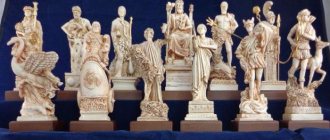» Feng Shui » The meaning of the hieroglyphs money and wealth
0
801
Article rating
The ability to write oriental symbols, such as the hieroglyph money, wealth and others, materializes the desired into the real. According to Eastern teachings, the correct image of the hieroglyph for material wealth opens the chakras responsible for the desire for enrichment.
The meaning of the hieroglyphs money and wealth
Hieroglyph of money
To be financially independent is a normal, natural desire for a person. Therefore, the hieroglyph money is one of the most common signs in the practice of Feng Shui.
Symbolism
This symbol consists of two parts. The meaning of the first is wealth, value. Presented in the form of the grapheme Gold. On the sign it is located on the left.
The element on the right is the background element. Allows you to understand what the pronunciation should be. But it also carries a certain meaning - to harm, to kill. This means that by owning finances, gold or other forms of money, people are able to fight, kill, and start wars. This is how the Chinese mean that money is not the most important value in life.
Effectiveness of the hieroglyph
The hieroglyph money and wealth is used to attract energy into life that will attract finance. People believe that it allows them to quickly find sources of income. Another positive effect is that it helps in finding a profitable business and contributes to the prosperity of the business.
This sign warns a person against thoughtless squandering and neglect of money. It is often used by bankers, financiers, and those starting a new business or project. But according to Chinese teachings, the sign brings good luck, love and happiness to other categories of people.
Blessing of the sky in the sign of "fu"
Every person from birth strives for good luck, happiness and wealth, fearing troubles and misfortunes.
But not everyone turns out to be worthy of these benefits. In Chinese culture, there is a clear relationship between moral principles and God's blessing. Everyone is equal before heaven, regardless of social status and origin. And they favor only those who perform good deeds and deeds, observing the moral principles established by God. Kind-hearted people sooner or later acquire divine blessings, receiving wonderful and effective help in all matters. As Sun Simiao, a physician who lived during the Tang Dynasty, said: “Good fortune is the product of the accumulation of good deeds, and misfortune is the result of accumulated evil.” Good will certainly attract happiness and good fortune, while evil will inevitably entail a series of misfortunes and troubles.
The hieroglyph “happiness”, being a symbol of goodness, prosperity and divine blessing, cannot guarantee the owner of all these benefits if his heart is filled with evil and cruelty. The lucky sign "fu" means self-improvement, faith in God and the desire to do good deeds.
Rules for using the money hieroglyph
In order for cash flows to start flowing, it is best to write this sign by hand. To do this, you can use a homemade stencil. To make it, you need to download an image of the hieroglyph, print it and cut it out. It must be attached to paper or other material and circled. Then paint the lines black or red. Using just a printed image will not bring any benefit.
Other principles and rules:
- It is advisable to use natural materials. They need to be painted on. These include stone, leather, wood.
- When writing, you should direct all your thoughts and concentration to receiving money, visualize the process of receiving and using it. You must try to materialize all your wishes.
- You should write according to all the rules of Chinese writing. The hieroglyph is displayed from top to bottom, then from left to right. This should be done slowly and carefully. Violation of these basic rules may cause a lack of positive effect from using the talisman.
- An item with the applied element should be stored in places where money is found. That is, in a wallet, handbag, purse, safe.
When receiving income, you should not keep it in the house for a long time. It is important to put it into circulation, helping to increase it.
Do not wrinkle, stain or bend banknotes or scratch coins. This will be a sign of disrespect on the part of the person. Money should be handled carefully.
Hieroglyph of wealth
Hieroglyphs can be applied to any thing
The hieroglyph of yuogathism carries the concept of great spiritual and material potential. It is not enough to buy it and wait for the profits to start flowing.
To achieve results, a person must work hard and hard to provide for his own needs. Only in this case, the image of the hieroglyph will increase your income.
Symbolism
It consists of two elements: home and abundance. It means not only financial independence, but also grace in various aspects of a person’s life, prosperity in the home, harmony with oneself.
If a person stays indoors with supplies of food, water, and clothing, his primary needs will always be satisfied. It aims to attract spiritual benefits such as love, happiness, longevity, and good luck.
Effectiveness of the hieroglyph
The hieroglyph of wealth promotes prosperity in current affairs and other endeavors. If the goal in itself is not to receive huge sums of money, but spiritual and moral benefits come first, then this element will be an excellent helper.
Rules for using the hieroglyph of wealth
The first rule is that it is recommended to install and store the symbol in the south-eastern part of the room. This principle is formed on the basis of the teachings of Feng Shui.
It is worth giving items with this sign:
- from the heart;
- with a good attitude;
- with good intentions;
- with a smile.
When giving a gift, be sure to say your wishes. First of all, wish the recipient an increase in income. In return, the donor receives positive energy and an even greater increase in benefits and wealth.
The hieroglyph wealth refers to activating talismans. When placing the poem indoors, you should not keep protective feng shui symbols nearby: the image of the Dragon, or the Fu dog. Otherwise, both talismans will not perform their functions, since their energy will block each other.
These ancient Eastern drawings contain a force aimed at achieving harmony between a person and himself, with the environment. Brings love and happiness. In order for the hieroglyph to take effect, a sufficient amount of time is required (from 2 to 6 months).
How to use it correctly?
Money requires responsibility, and in order to attract it, it is important to consider the following principles to correctly use this symbol:
- Do not use a hieroglyph if you are in doubt about its meaning. In this case, it is recommended to obtain updated information or seek clarification from an expert.
- Study its functions carefully. They must clearly meet the given goals.
- The symbol should not be placed next to protection amulets, as this will interfere with the formation of monetary energy and reduce the chances of getting rich in this way to zero.
- If you apply a drawing yourself, it acquires an unusually powerful force. And if your artistic abilities leave much to be desired, or you doubt the correct spelling of a symbol, make a stencil by printing it from your computer and tracing it.
- Give the symbol as a gift, and it will attract wealth and cash flows to you. It is important that the gift is made from the heart, and good luck is wished sincerely. After all, the more we wish happiness for others, the sooner we will become happy ourselves.
- The effect will not appear immediately. You will have to wait one or two months before the symbol takes effect. At the same time, the process will take place gradually, so do not expect untold wealth to fall on you overnight.
- The symbol encourages you to handle money responsibly, without going to the extremes of excessive spending or constant accumulation. A person is worthy of wealth only if he knows how to properly manage cash flows. At the same time, banknotes should not be scattered randomly everywhere, dirty, crumpled, or folded several times. With careful handling, they will flow into your hands.
Application of hieroglyphs
Talismans for money and wealth
Usually things and objects with these designs serve as talismans and amulets. Girls use them as original jewelry and tattoos in order to increase love and happiness in their lives.
Often, wanting to please a person, a specific souvenir is purchased with an error in the spelling of the sign. And often the donor does not understand the intricacies of this culture and is not always able to notice the mistake. As a result, such a thing, when it gets into the house, is of no use.
As souvenirs, the hieroglyph is applied to:
- piggy banks;
- ceramic and clay sculptures;
- paintings;
- sky lanterns;
- watch;
- costume jewelry, etc.
Real craftsmen paint dishes very beautifully. They put the hieroglyph money on gift sets, vases, teapots, and wooden tablets.
Chinese craftswomen love to sew hieroglyphs on clothes, silk dresses, and cotton sweaters. Some people decorate bags and wallets with this symbol. Young people prefer designs on the body in the form of tattoos, manicures, and makeup.
Story
The Chinese character for “happiness” appeared with the advent of writing about a thousand years ago and initially had a slightly different meaning. According to the designs on ancient fortune bones, the "fu" sign was associated with the altar and the worship of the gods in the hope of receiving the blessings of heaven. The desire to achieve “fu” was reflected in ancient culture; the hieroglyph became the basis for numerous rituals and worship ceremonies.
The tradition of hanging a hieroglyph on the doors of houses is associated with the legend of Jiang Taigong - the god of gods, whose great mission was to assign corresponding positions to heavenly rulers. According to legend, Jiang Taigong lived during the Zhou Dynasty and was subordinate to the Supreme Heavenly Lord. The impetus for the emergence of such a custom was the request of Jiang Taigong’s wife to make her a goddess. To which the god of gods replied: “Since I married you, poverty has settled in my house. So be the goddess of poverty. Your domain will be where there is no happiness.” Having appointed his wife to a new position, Jiang Taigong introduced the tradition of hanging an image of a hieroglyph on the doors so that the goddess of poverty could never enter such houses.
Where should hieroglyphs be placed?
The correct choice of place to place a picture with a hieroglyph of money and wealth determines how strong the influence of the symbol on a person will be. According to the teachings of Feng Shui, objects with the hieroglyph of wealth should be placed on the left side of the table, cabinet, or shelf.
This should not be done too high. The optimal height is up to 1 m.
If the hieroglyph is designed in the form of a picture, it can be hung on the wall. It is necessary to choose the right room in the house. It is not recommended to hang the picture in the bathroom and bedroom. The ideal place is the kitchen, hallway or hall. Remember, the painting must be framed in a golden color.
If the image of the hieroglyph is planned to be placed in the office, then it is better to hang it in a visible place. This could be a work area near a desk or computer. It is also allowed to place a picture with a symbol on the wall in the office where the most workers are located. If this is the director's office, then according to Feng Shui, the painting should be in the south-northern part or on the back wall.
Protection
Any thorny plant or sharp object was revered by the ancient Slavs as a talisman against evil spirits and the evil eye. This is due to their ability to wound, cause pain, and dig into the body.
To protect against evil people and spirits, the plant itself with thorns, and not a symbol, was used. Here are some ways to use it:
- during pre-wedding rituals, it was the custom to sweep the road in front of the bride with a burdock broom in order to scare away evil spirits;
- the thorns were placed in the keyhole;
- burdock was braided around walls, windows, doors, and placed under the threshold;
- a bunch of burdock was placed in the coffin of a supposed witch or vampire so that it would cling to the undead and not let go of the grave;
- it was thrown into the fire if it was necessary to drive away spirits;
- plug up all the holes and holes in the hut to get rid of mice.
The amulet was used mainly on days of rampant evil spirits: Ivan Kupala, Christmastide, Spiritual Day. Even before nightfall, huts, barns, and stables were surrounded with thorns, and fires were lit in the courtyards to ward off evil spirits that could harm people and livestock and spoil the harvest.
Similar customs have been preserved in many modern villages. In the fall, housewives place burr heads between windows, in cracks, in mouse holes, under the threshold, so that no evil will enter the house.
